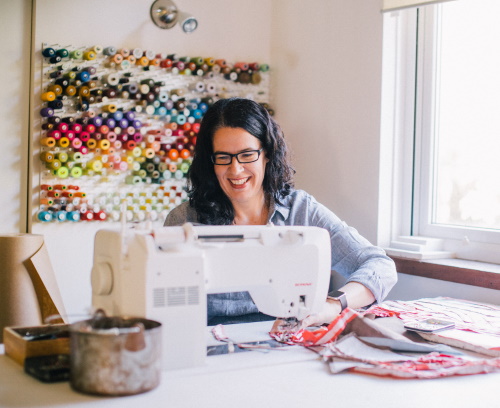Welcome to the fifth in my Three Questions series, where I ask makers about their creative practices. I became aware of Ruth’s quilts over 10 years ago, when I was editor of a now-defunct quilt magazine and I have followed her work since.
Ruth stitches together lots of little pieces of fabric to make bold textile paintings. Her process incorporates traditional quilt-making techniques that are applied in a contemporary way. Ruth also illustrates children’s books.

How did you get started on your creative path?
“I grew up in a creative home, with a needle and thread in hand, so moving into textiles as an art form was a natural progression from there. My year 12 art lessons gave me a really good basis for what I do now and that was when I discovered that quilts could be art, through the work of Western Australian artist Wendy Lugg.
“I came back to art and textiles when I became a stay-at-home mum with my first child (I studied Science and Engineering before then). Creating through drawing and stitching has been a beautiful journey in conjunction with motherhood, with the creativity enriching my role as mother, and motherhood speaking back into my creative work. My pursuit of quilts as an art form began in earnest after successfully participating in our state quilt show.
“My illustration career is developing out of my textiles journey. I have kept a sketchbook (and maintained a regular drawing practice) since leaving high school. My illustration skills have drastically improved by regularly drawing children in order to design my childhood art quilts, to the point that I have now illustrated a couple of children’s picture books. So much fun!”

What satisfies you about the creative work you do?
“I have felt the need to make things since before I started school. It’s part of who I am. Watching an idea take shape – whether on paper or in fabric – is incredibly fulfilling. I love the tactile nature of thread and fabric. I think there is something nurturing about it.
“My favourite part of my textile art process is stitching the little pieces together, especially by hand. Not only do I get to enjoy the process of passing needle and thread through the fabric, but I also get to watch the image of the artwork grow with every seam.
“I have also experienced so much joy in the process of illustrating a picture book. It’s a bit like planning a solo art exhibition or a series of artworks, in that you get to explore an idea and a cast of characters over a series of illustrations, rather than just one stand-alone drawing. (One of my creative challenges is that I always have too much to say to fit into just one artwork or illustration…).”

How do you stay inspired to create?
“For me, it’s important to maintain regular creative habits. I try to do some drawing or stitching every day, even when I don’t feel like it. Showing up when you’re unmotivated is an important part of making creative work even when you are not bursting with creative ideas.
“I’m very goal-driven, so I make a point of setting annual, monthly and weekly creative goals for myself, and breaking those goals down into manageable tasks. This is also helpful for making even when you don’t necessarily feel like it, especially if you have already noted which tasks need to be completed next (examples might be: ‘brainstorm ideas for main character of story’, or ‘enlarge and trace quilt design for upcoming exhibition’ or ‘spend 2 hours piecing quilt entry for upcoming exhibition’).
“I also regularly refer to my Pinterest boards. I see this as a bit like a beautiful glossy magazine perfectly curated to my own taste. I try not to stick to pins in my own genre of creativity, but to draw inspiration from all areas of life. I like to browse my boards every so often to note which pins excite me, and think about why. Often there are common factors like some bold use of colour, or the layering effects, or the use of typography.”

Follow Ruth online

Thank you Ruth, for sharing insights of your creative life.
Thanks for profiling Ruth, Erica. Her new book is lots of fun, and I’ve had reason to mention her work to some artists here, so it is great to have your interview to direct them to also.